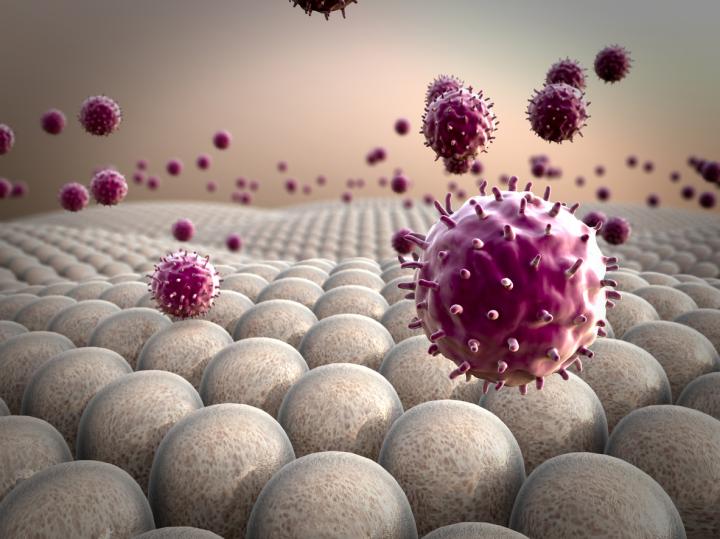

Macrophages are immune cells just like T and B cells, but differ in that they can eat cells that are not supposed to be in the body.
Credit: Penn Medicine
Immune cells called macrophages are supposed to serve and protect, but cancer has found ways to put them to sleep. Now researchers at the Abramson Cancer Center of the University of Pennsylvania say they've identified how to fuel macrophages with the energy needed to attack and eat cancer cells.
It is well established that macrophages can either support cancer cell growth and spread or hinder it. But most tumors also express a signal called CD47, which can lull macrophages into a deep sleep and prevent them from eating.
Researchers have found that rewiring macrophage metabolism can overcome this signal and act like an alarm clock to rouse and prepare macrophages to go to work. Their findings were published in Nature Immunology today.
Macrophages are immune cells just like T and B cells, but differ in that they can eat cells that are not supposed to be in the body. In fact, they are the most prominent immune cell found in cancer, but unfortunately, most are often convinced to help cancer grow and spread.
Cancer cells frequently stop macrophages from attacking them by expressing CD47, a “don't eat me” signal. Researchers now say that merely blocking inhibitory signals like CD47 is not always sufficient to convince macrophages to attack cancer. Instead, two signals are required.
First, they need a signal to activate them – such as a toll-like receptor agonist. After that, a second signal – such as a CD47 inhibitor – can lower the threshold needed to wage battle on the cancer.
“It turns out macrophages need to be primed before they can go to work, which explains why solid tumors may resist treatment with CD47 inhibitors alone,” said the study's senior author Gregory L. Beatty, MD, PhD, an assistant professor of Hematology-Oncology at Penn's Perelman School of Medicine. Jason Mingen Liu, an MD and PhD graduate student in Beatty's lab, is the study's lead author.
The team used this approach by activating macrophages with CpG, a toll-like receptor agonist that sends the first signal, and found that it rapidly induced shrinkage of tumors and prolonged survival of mice even without the requirement of T cells. Unexpectedly, they also found that the activated macrophages were able to eat cancer cells even in the presence of high levels of CD47.
To understand the molecular basis of this phenomenon, the team traced the metabolic activity of macrophages and determined that activated macrophages began to utilize both glutamine and glucose as fuel to support the energy requirements needed for them to eat cancer cells.
This rewiring of the macrophages metabolism was necessary for CpG to be effective, and the researchers say these findings point to the importance of macrophage metabolism in determining the outcome of an immune response.
“Cancer does not shrink without the help of macrophages and macrophages need the right fuel to eat cancer cells and shrink tumors,” Liu said. “To do this, a shift in metabolism is needed to steer the energy in the right direction. It is the metabolism that ultimately allows macrophages to override signals telling them not to do their job.”
Beatty points out that patients with diabetes, cardiovascular disease, and other conditions are routinely treated with drugs that could affect macrophage metabolism, but virtually nothing is known about how these drugs might impact immunotherapy responses in cancer, meaning the team's discovery has implications even for existing treatments.
###
Collaborators on this study include Nathaniel Snyder, an assistant professor at Drexel University, and Roddy O'Connor, PhD, a research assistant professor in Pathology and Laboratory Medicine at Penn.
This research was supported by the National Institutes of Health (R01 CA197916, R03 HD092630, F30 CA196124) and the Seed Grant Program from the American Medical Association Foundation.
Penn Medicine is one of the world's leading academic medical centers, dedicated to the related missions of medical education, biomedical research, and excellence in patient care. Penn Medicine consists of the Raymond and Ruth Perelman School of Medicine at the University of Pennsylvania (founded in 1765 as the nation's first medical school) and the University of Pennsylvania Health System, which together form a $7.8 billion enterprise.
The Perelman School of Medicine has been ranked among the top medical schools in the United States for more than 20 years, according to U.S. News & World Report's survey of research-oriented medical schools. The School is consistently among the nation's top recipients of funding from the National Institutes of Health, with $405 million awarded in the 2017 fiscal year.
The University of Pennsylvania Health System's patient care facilities include: The Hospital of the University of Pennsylvania and Penn Presbyterian Medical Center — which are recognized as one of the nation's top “Honor Roll” hospitals by U.S. News & World Report — Chester County Hospital; Lancaster General Health; Penn Medicine Princeton Health; Penn Wissahickon Hospice; and Pennsylvania Hospital — the nation's first hospital, founded in 1751. Additional affiliated inpatient care facilities and services throughout the Philadelphia region include Good Shepherd Penn Partners, a partnership between Good Shepherd Rehabilitation Network and Penn Medicine, and Princeton House Behavioral Health, a leading provider of highly skilled and compassionate behavioral healthcare.
Penn Medicine is committed to improving lives and health through a variety of community-based programs and activities. In fiscal year 2017, Penn Medicine provided more than $500 million to benefit our community.















